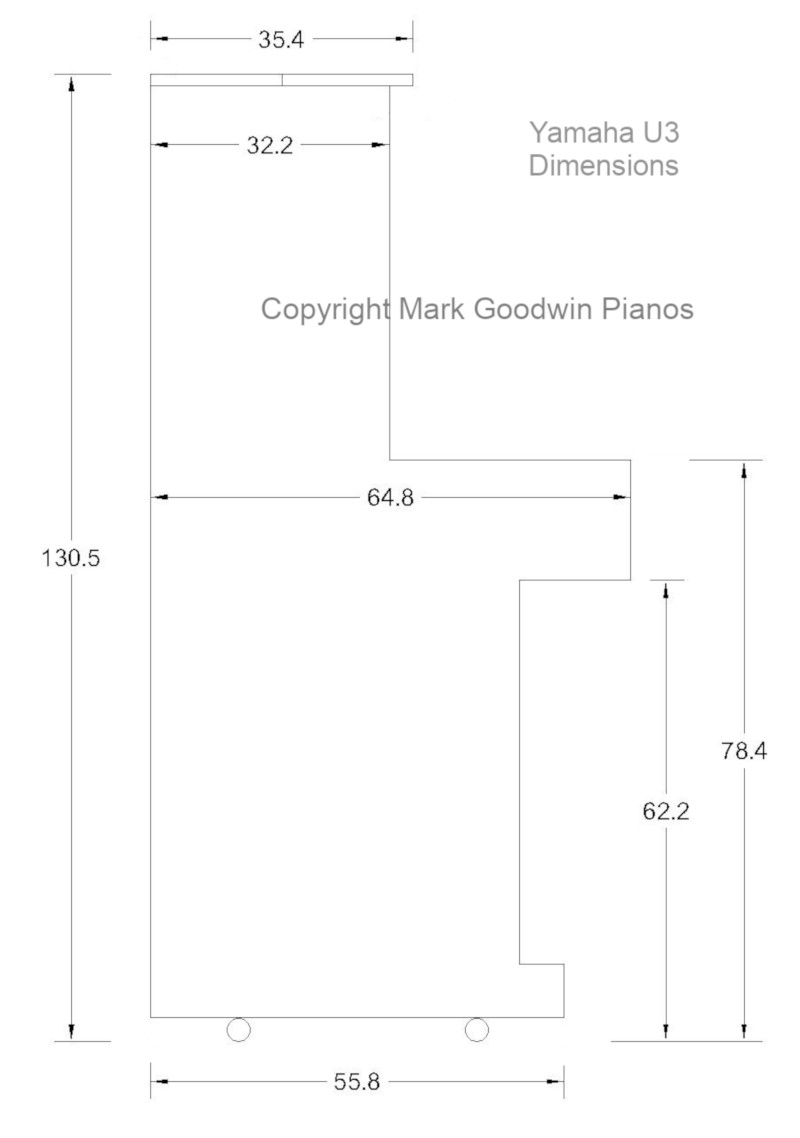Yamaha U3 and U1 Differences. Which is best?
The main difference between a Yamaha U1 and a Yamaha U3 is that the U3 is 10cm taller and a little bit deeper (measuring from front to back). This gives it 3 main advantages:
Physical differences
1. The extra height of a Yamaha U3 means that it can house longer strings which result in a warmer, richer sound. The reason a concert grand sounds so amazing is largely due to the very long strings it houses. Similarly, the reason a Yamaha U3 sounds so much better than a Yamaha B1 or any other short upright piano is that the U3 has a much longer strings.
2. The larger cabinet of the Yamaha U3 also allows it to house a larger soundboard which is good for producing a richer, more resonant tone. I refer you again to concert grand pianos with their long strings and large soundboard.
3. Finally, the extra space created inside the Yamaha U3 cabinet allows it to house longer keys and a taller action, which gives it a touch very close to that of a grand piano. Regarding the longer keys, the U3’s 40.4 cm key depth gives you more room to control your playing, making it easier to shape tone and dynamics. It also feels more balanced and comfortable, especially during longer sessions. Compared to the U1’s 37.5 cm, it offers a noticeably more refined and responsive playing experience.
- View our 24 Yamaha pianos for sale in our Manchester, London and Birmingham piano shops.
- Yamaha U1 rental from £99 per month
- Upright pianos vs baby grand pianos
If you sit and play a Yamaha U3 next to a Yamaha U1 you can feel this difference. A U1 can feel a little bit “shallow” to touch compared with the deeper, smoother, more comfortably balanced touch of the Yamaha U3. Technicians and pianists alike comment on the better level of control you can achieve with the U3 action compared with the U1.
Other than that, they are equal. The build quality and component quality is just as good. The U1 is not a small piano so it does still have a good, rich tone, just not quite as rich as the U3. So if your budget will stretch I recommend the Yamaha U3.
Tonal differences
Play this video and see if you can hear the difference.
Bright, medium or mellow
Some of my U3 pianos are bright, some are medium and some are mellow. This is mainly down to the soundboards and hammers being unique from one piano to the next. The job of the soundboard is to amplify the vibrations from the strings and so each different soundboard gives each piano it’s own unique “voice”.
U1s are typically brighter
However, when it comes to the Yamaha U1 pianos, they seem to have a much more consistent tone, there is less variation between bright and mellow. I’m not certain why that is but it does tend to be the case. It is therefore quite easy to choose a Yamaha U1 because they all sound so similar.
Room choice
Choosing a U3, however, is, therefore, a bit trickier because you have to figure out if you like a mellow, bright or medium tone. It’s good to have the choice of course because for a room with a hard floor and no soft furnishings you should look to choose a mellow piano. For a room with a heavy carpet and curtains etc a brighter piano would be a better choice. So it’s good that the U3s give you that choice of tone.
Stock levels
The Yamaha U3 is much more popular than the U1 and so I try to keep more U3s in stock than U1s to give my U3 shoppers a bigger choice. I probably sell five U3s to every U1 and the reason for this seems to be that once a person has decided that they are spending this much money, they don’t mind stretching that bit further to get the best sound quality possible. There is a £500 difference between a U1 and U3 of identical age and condition.
Yamaha U1 and U3 dimensions
Yamaha U1 Dimensions
Height: 48in / 121cm
Width: 60in / 151cm
Depth: 24in / 61.5cm
From floor to keyboard: 24in and 1/16th / 61.2cm
Profile view

Yamaha U3 Dimension
Height: 52in / 130.5cm
Width: 60.5in / 153.5cm
Depth: 25.5in / 65cm
From floor to keyboard: 24.5in / 62.2cm
Profile view

Cardboard cutout
If you are worried about whether a Yamaha U1 or U3 will fit into your house, please create a cardboard cutout using the above diagrams. If you can slide the cutout along the floor and around the tight corners without touching the walls then the piano will fit. Try the cutout in various orientations if it doesn’t fit at first. Flip it over and try going in top first and then bottom first to see what works best.
I hope this info helps
Thanks
Mark










